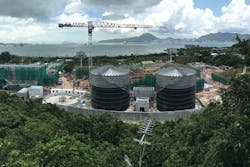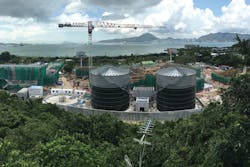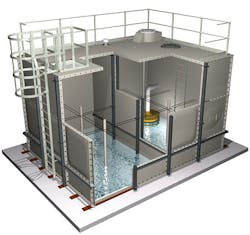Selecting a Water Storage Tank
When it comes to large-volume water or wastewater storage it is important to understand that you have a choice of tank type and that the one you choose must suit your particular project or installation.
There are a number of tank options available when considering water and/or wastewater storage. Here are some guidelines for selecting the correct tank for your project and maintaining it for long and trouble-free service.
Cylindrical Steel Water Tanks
Cylindrical steel water tanks are available in fusion-bonded epoxy coating, galvanized and stainless steel, and the range of materials offered provides cost-effective and project-specific options for the potable, irrigation, fire protection and wastewater sectors, amongst others.
Cylindrical tanks are available in capacities from 10,000 to over 4,000,000 gallons. They are built using lifting jacks, allowing the tanks to be erected within days by a small team. The process of being built ‘from the top down’ reduces health and safety risks by removing the requirement of working at height.
Being a very flexible product in terms of size, the tank can be built to greater heights using a smaller footprint if desired or can be of greater diameter and lesser height depending on space availability.
GRP Sectional Water Tanks
Glass-reinforced plastic (GRP) tanks are built on site by bolting together panels that typically measure 3.3 x 3.3 feet and 3.3 x 1.65 feet. A sealant is placed between each panel to ensure water-tightness. GRP tanks are generally 13 feet in height and can be built to almost any width and depth. They are commonly used to store water in capacities of 264 to 26,420 US gallons with insulation options available.
Steel Sectional Water Tanks
Steel panels should be manufactured to BS1564:1975 Type 1 (Hot Pressed) standards and bolted to the adjacent panel using an approved sealant. The panel thicknesses depend upon the size and depth of the finished tank and range from 1/8 to 1/6 inch. Tanks are built on site to 16.5 feet in height and to any width and depth, giving almost infinite storage capacities.
Steel sectional tanks are specified over GRP where there is a risk of earthquakes as they are less likely to fracture when seismic activity takes place.
Inspection, Maintenance and Repair
As with any product, it is important that water tanks are inspected and maintained regularly. Regular maintenance should include internal and external visual inspections and, where required, ultrasonic thickness measurement, internal ROV (remotely operated vehicle) inspection, cleansing and disinfection. Roof structures and supports should be inspected, fittings and fastenings checked, and internal and external seals and seams should be checked for water-tightness.
Balmoral Tanks will be exhibiting at WEFTEC.17, Booth 5620. For more information, visit balmoral-group.com.


